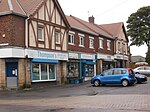Deckham is a residential suburb in the Metropolitan Borough of Gateshead in Tyne and Wear, England. It is bordered by Gateshead town centre to the north, Sheriff Hill to the south, Felling and Carr Hill to the east and Shipcote to the west. It lies on the B1296, the route of the old Great North Road, 1 mile (1.6 km) south of Gateshead town centre, 1.5 miles (2.4 km) south of Newcastle-upon-Tyne and 13 miles (21 km) north of the city of Durham. In 2011, Deckham had a population of 9,938.
Deckham's history is sparsely documented but suggests that the settlement was established at the junction of Carr Hill Road and the Old Durham Road in the early 19th century alongside the estate of Deckham Hall, built several centuries earlier and inhabited at one time by Thomas Deckham. The village grew, and at the turn of the 20th century was enveloped by urban spawl when neighbouring Gateshead absorbed its outlying villages and settlements. Deckham is largely distinguished from other areas by a commercial area on Old Durham Road which is the principal route through the suburb. Historically, Deckham was a village in County Durham and was incorporated into the Metropolitan Borough of Gateshead by the Local Government Act 1972.
Deckham has steep topography which has shaped the character of the suburb. Residents can enjoy striking views towards Newcastle upon Tyne and across the Team Valley. The settlement is governed locally by a Parliamentary Labour council and elects a Labour MP.
Deckham is an area of social and economic deprivation, in the top ten per cent of such areas according to the Index of Multiple Deprivation. Housing stock is predominantly council housing and is, in many places, outdated and in need of modernisation. Whilst once the site of a coal mine, there is today no major employer in Deckham, which is considered a residential suburb of Gateshead. The main economic activity is in a commercial development on Old Durham Road. Deckham has a number of public houses, one of which, the Plough Inn, is more than 150 years old. The only education provision is at South Street primary school, which is a good school according to OFSTED. There are two churches, one of which, the Church of St George, is a Grade II listed building, and community facilities are provided by Gateshead Older People's Assembly and the Elgin Centre in Carr Hill.








